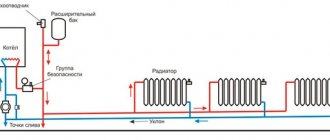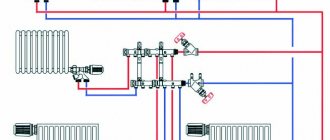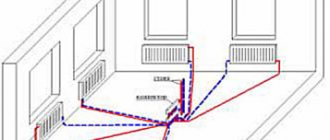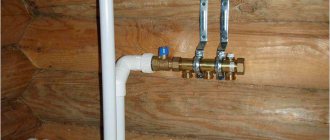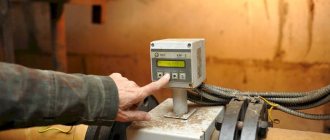Vortex heating device
This meter can be installed on pipes, both horizontal and vertical.
The principle of operation is to measure the speed and number of vortices. That is, this is an obstacle to the flow of water; the water bends around the obstacle and, as a result, vortices are created. It is not sensitive to the manifestation of various blockages, for example, rust, scale, etc. This meter can only give incorrect readings if there is air in the system. Complete set of vortex heating device:
- Counting mechanism;
- Frame;
- Plates;
- Heat fairing;
- Filter.
Rice. 5 Vortex device
The vortex counter is installed horizontally between two pipes.
General and individual meters
The heat meter can be installed on:
- the central collector of a multi-storey building - the heat received by all apartments connected to the riser is taken into account;
- separate pipes - the resource entering a specific apartment is registered.
Ultrasound devices are used individually. Mechanical, electromagnetic and vortex devices can be installed both for the entire house and for a separate apartment.
Read in a separate article: Hot water meters with a temperature sensor and their features.
Common house
The house-wide heat meter is connected to the main riser, which is located in the basement and supplies heat to all apartments. How to calculate heating in an apartment using a meter? Cost accounting is carried out as follows:
- On a certain date of the month, current heat meter readings are taken.
- The difference between them and the previous number of gigacalories is found.
- The resulting number is multiplied by the current tariff assigned by the state.
- The amount is divided between apartments in proportion to their area.
As a result, residents pay for the heat that is supplied to their apartments and also used to heat stairwells, basements, attics, and so on. Community meters are expensive. The price of the device itself can reach 150,000 rubles, in addition, there are costs for its installation and maintenance. All costs are divided equally between the apartments. In many cases, residents are allowed to pay the amount in installments over time.
Household ultrasonic meter
Individual
With all their advantages, communal heating meters have some disadvantages:
- To install the device, the consent of all residents is required, which is sometimes impossible to obtain;
- the device does not take into account the uneven distribution of heat - in insulated apartments that are located in the middle of the house, the temperature will be higher than in corner and “ventilated” ones, but the payment is the same for everyone (taking into account the area);
- Even if there are thermostats on batteries, it makes no sense to screw them on in order to save money, since this does not affect the amount of payment for heating.
Meters for heating batteries in the apartment will help solve these problems. The costs of purchasing, installing and ongoing repairs of the device fall entirely on the shoulders of the home owner, but he gets the opportunity to clearly control the heat received on his own. The device is mounted on an individual riser that supplies coolant to the apartment.
Before making a decision, you should find out whether it is possible to install a heating meter in the apartment? The fact is that in most old houses the wiring from the riser goes vertically, that is, each radiator has its own pipe. It turns out that all of them need to be equipped with devices. But this is very expensive, and in addition, it is almost impossible to reconcile the readings of many meters. The way out of the situation is to install distributors on all radiators. These devices determine the temperature difference on the surface of the battery and in the room.
Radiator distributor
However, not all operating companies accept such readings to account for the heat received and calculate the cost of services. With horizontal wiring of the heating system, you can install any type of meter.
Advantages of devices
In addition to the fact that installing individual heat meters in an apartment allows you to make payments depending on the readings, it undoubtedly has other advantages.
Heat meters for apartments
These characteristic advantages include:
- Private meter installations in a residential area allow you to regulate energy consumption depending on weather conditions. This is mainly in demand during the spring and autumn periods, when the temperature outside can change every day.
- Using the device, you can detect malfunctions in the coolant line (air pockets, blockages). This leads to an uneven supply of heat, which, of course, will immediately appear on the meter readings in the apartment.
- The installation of individual heat meters is also necessary because utility organizations calculate heating fees according to established standards, and not based on actual consumption. With the device, every month the heat in the apartment will be metered according to the readings.
Thus, the benefit of installing individual heat energy meters in an apartment is obvious.
On a note. A heat meter installed on hot water supply (DHW) will quickly justify its cost if the heating in the house is of poor quality. This is possible because if the meter readings are below 40˚, the calculation is made as for cold water (according to Government Decree No. 354).
Meanwhile, the installation of such devices has a number of features, and therefore it is necessary to pay special attention to them.
Heat meters in the apartment
Individual products have a small pipe flow area, not exceeding 20 mm, and the calculation occurs in the range from 0.6 to 2.5 m/h. This is allowed based on the coolant flow rate and the different water temperatures in the inlet and outlet pipes of the heating main.
Heat meter connection diagram for apartments
This happens in this way: a meter and a heat calculator are mounted on a liquid heating system device, the operation of which is provided in pairs. Two temperature sensors branch off from the second device, one of them is mounted on the inlet pipe, and the other on the outlet pipe.
As a result, the recording device collects the necessary readings from individual meters and, using special transformations, displays the amount of heat consumed on a scale.
How the battery meter works
Let's take a closer look at how the heating meter works and what factors can affect its functioning.
A heat meter is installed to determine the volume of coolant in the radiator, as well as measure the water temperature level.
If the house has horizontal wiring, the unit is mounted on a horizontal pipe. At the same time, one device per apartment is quite enough. But with vertical piping, you will have to install a separate meter for each battery.
It should be noted that the heating meter in the apartment is quite accurate. But there are a number of factors that can have a strong impact on the device and cause some error. For example:
- The circulation of the coolant is disrupted, low flow is observed.
- There is a thermal difference that is less than +30 degrees.
- The meter was installed incorrectly. For example, temperature sensors are installed incorrectly.
- The quality of the pipeline and water is poor. For example, the water is too hard and has various impurities such as sand and rust.
What types of heating meters are there?
Depending on the installation method, the heating meter can be communal or individual.
With the common building option, one metering device is purchased for the entire high-rise building. Despite the fact that the meter is expensive, it will be quite affordable for the owner of each apartment. After all, the total price will be divided among all residents. Despite the availability of a heat metering unit, savings may be low due to the fact that some apartments may be poorly insulated. As a result, everyone will have to overpay. Therefore, many people prefer to install an individual meter on the heating battery. to pay only for the heat actually received by the apartment. True, such a device is not suitable for every room. For example, installing a meter in an old house with a vertical type of wiring can be quite problematic. After all, the device is installed on a riser. And in such houses there are several of them. Installing a meter on each riser is very expensive. In this case, distributors are used. Also, all heating meters for an apartment can be classified according to their operating principle into:
- Ultrasonic. They are used most often. They are considered the most accurate, durable and reliable. The error may be caused by particles of debris entering the signal receiver and the formation of air bubbles.
- Mechanical. Suitable for use in conditions of contaminated or salt-saturated circulating fluid.
- Electromagnetic. Fairly accurate. They are distinguished by stable operation.
- Vortex. The principle of operation is that data on the strength of the vortices formed after the passage of the circulating fluid is compared.
Features of installing a heating meter
It should be noted that independent installation of heating meters in the apartment is unacceptable. This may result in refusal of registration, and the personal account will not be re-registered
It is also important to remember that the unit should be checked every four years.
To install the device, you need to perform a number of steps:
- get permission;
- study technical conditions;
- create a project, it must be agreed upon with the heating company;
- install the unit.
How much will it cost to install a heating meter?
For those who want to spend money wisely, a heat meter is the best investment option.
Of course, the price of the device is considerable. But if you consider that the purchase pays for itself fairly quickly, the meter is not that expensive. The price for a communal heating meter is more affordable than for a unit installed individually for one apartment. The cost of devices depends on the type and manufacturer. We must remember that in addition to purchasing the device itself, you will also have to spend money on its installation. After all, installation should only be performed by a professional. It must be said that the price of heating meters includes, in addition to the equipment itself, some components: shut-off valves, control valve, filter. The average cost is from 9,000 rubles. If you add installation costs to this, the amount can rise to 20,000 rubles.
It is very profitable to buy meters in bulk: at the same time, the price for a heating meter will be slightly lower. This is possible, for example, if other residents plan to install this unit at the entrance for their apartments.
Checking heat meters
Typically, new devices are sold with an initial test, which is carried out at the factory that produces them. Proof that the verification of heat meters has been carried out is the presence of a special sticker corresponding to the entry, a special mark, both on the devices and in the documents attached to them. During operation, verification of heating meters is carried out at the expense of apartment owners once every 4 years; to carry it out, you must contact a number of organizations and institutions:
- to the Rostest department;
- to a company that has the appropriate authority to carry out the inspection;
- to the service center of the manufacturer.
They independently take readings from the heating meter in the same way as from the electric meter. The payment receipt indicates the difference in readings, multiplies it by the established tariff and makes the payment, for example, in one of the Sberbank branches. The recipient of the payment is the heat supply organization.
Heat meters - installation advantages, detailed video:
Ultrasonic heating heat meter
This type of meters is most often installed as a common device for apartment buildings. The principle of its operation is an ultrasonic signal, thanks to which the device actually takes measurements (using a sensor). This signal is passed through the water. The configuration of this device consists of an emitter and a device that emits a signal. These components are installed one opposite the other.
Rice. 3 Ultrasonic device
It is better to install an ultrasonic device in houses with new pipelines, as they are very sensitive to contamination.
There are the following types of ultrasonic heat meters:
Each of these types gives accurate readings only if the water is clean and free of impurities. Any dirt or even air bubbles will affect the readings.
The advantages of this meter include the information content, which is achieved thanks to the liquid crystal display, and the fact that when installing this model, the hydraulic pressure does not increase.
But there is also one disadvantage in the operation of the ultrasonic device: if the power supply is unstable, then it is connected via UPS.
Types of heat meters
Types of heat meters
Before installing a heating meter in an apartment, you need to choose the right model. Currently, manufacturers offer several options for these thermal energy metering devices. They differ in the principle of taking readings, accuracy and cost.
Considering the general operating principle of a heating meter, they all consist of three separate elements:
- Warm water flow metering unit;
- Two temperature sensors;
- Electronic unit for processing received information from the first two devices.
The difference between the models of heating meters for the battery lies in the principle of taking readings from the coolant volume meter. The remaining components have minor discrepancies between the actual and calculated data on the temperature of hot and cooled water.
The choice of a heat meter for heat supply in an apartment is not affected by the size of the electronic unit. It can be located at a distance from the installation site of the water flow meter.
Mechanical heat meters
These are the simplest and most affordable devices for completing central heating meters. They work on the principle of converting the translational movement of the coolant into the rotational movement of the flow metering unit.
Depending on the operating principle, mechanical heating meters are divided into several types:
The main disadvantage of these devices is the high error with sudden changes in the speed of water movement. You also need to take into account that the rotational element creates a path and small hydraulic resistance. The composition of the coolant has a great influence on the quality of operation of an individual heat supply meter. Mechanical models are not suitable for hard water. In this case, they must be replaced with contactless analogues.
The average cost of mechanical (tachometer) models ranges from 4 to 9.5 thousand rubles.
The easiest way to fool a mechanical heating meter. To do this, it is enough to install powerful neodymium magnets on it. But in addition to a possible fine, such a “modernization” can lead to rapid failure of the device.
Vortex heat meters
The best option for operating a heating meter is to take current readings without directly affecting the coolant flow. Vortex models can be classified as such devices.
Its operating principle is based on the analysis of vortex anomalies that arise due to an artificial obstacle. This design allows you to accurately obtain readings of the volume of water passing through the device. It is also necessary to note the following positive qualities of a vortex heat meter for heating radiators:
- Optional presence of straight sections. This condition must be met only for mechanical models of metering devices;
- The composition of the water will not affect the error, nor will it affect the condition of the meter;
- The presence of metal impurities will not affect the accuracy.
However, the disadvantages of this metering device must also be taken into account. These include the effect of air pockets on the error. Also, the high cost of vortex metering devices makes them unpopular for installation in a heating metering system in private houses and apartments. They are most often used in industrial and commercial areas. Unlike mechanical models, the position of the vortex counter does not affect its operation.
Ultrasonic heat meters
The most unpopular type of heat meters. They work on the principle of changing the time it takes for a sound signal to travel through a liquid. This in turn depends on its speed.
The accuracy of readings is affected by the design of the central unit. It can be of the following types:
An important nuance is the purity of the coolant. It should be free of foreign impurities in the form of scale, rust or high metal content. Otherwise, the accuracy of the instrument readings will significantly deteriorate. Therefore, ultrasonic models are used to a greater extent in closed systems, where accounting for water flow is necessary for organizing the production process.
Even installing a good filtration system will not completely guarantee the absence of third-party impurities in the coolant. Therefore, it is best to refrain from installing ultrasonic meters for your home or apartment.
Classification and principle of operation of heat meters
The priority principle of operation of all similar products for metering thermal energy is readings at a certain water temperature.
Any heat accrual device consists of three components:
- Sensor;
- Unit for distribution, pressure and fluid resistance;
- Device for metering received thermal energy.
Scheme of the operating principle of a common house heat meter
In addition, meters are divided by purpose. They are available for individual and industrial (household) use.
Devices for houses with autonomous heating and apartments differ from house ones in more precise adjustment.
Heat energy metering devices for home use are divided into several types:
- Mechanical;
- Electromagnetic;
- Ultrasonic;
- Vortex devices.
To better understand their fundamental work, let’s look at each variety in more detail.
Tachometer instruments
The most affordable and understandable from the point of view of the average person are mechanical devices. Such devices use a rotating drum in the form of a small turbine as a meter.
Tachometer heat meter
It rotates from the pressure of the coolant, thanks to which water consumption is recorded. Typically, tachometer meters are equipped with two flow meters (on the inlet and outlet pipes), a resistance element and a heat calculator.
Sometimes devices are provided with pressure sensors. Such meters must have filters installed at the entrance. If the equipment is put into operation without them, then the presence of mechanical impurities (particles of sand, gravel, rust) will affect the operation of the device, and it will produce distorted readings.
Electromagnetic devices
This device's operating principle is based on the manifestation of electromagnetic induction. Inside the product there are several magnets that create a field of the same name.
Electromagnetic heat meter
As you know, water is a good conductor and when it passes through a magnetic field, an electric current is generated. Moreover, its value is directly proportional to the speed of fluid flow.
The generated electric current enters the computing node. And since the difference in current values is small, such devices require proper installation and special operating conditions.
Data readings will be distorted if the device is connected in violation of the required level (vertical instead of horizontal heating distribution in a high-rise building). And also at the junction there should not be a narrower throughput channel.
And one more factor that influences the reliability of information for coolants of this type is that the presence of iron in any form (scale, rust) is excluded in the water.
Ultrasonic heat metering
Meters with ultrasonic radiation are characterized by an unusual operating principle and high cost. The originality lies in measuring the passage of a wave through a liquid, depending on the speed of the coolant.
Ultrasonic heat meter
In other words, the flow rate is calculated by the time it takes for the signal to arrive from the radiation source to the receiver. In these products, strict placement of devices on the same line is important.
Vortex heat accounting
Turbulent-type devices are distinguished by a special measurement. In the path of the coolant in the pipeline there is a prism, which is an obstacle, and a vortex flow occurs.
Vortex heat meter
The number of vortex branches is recorded by special sensors and flow meters, which are located at a certain distance from the prism. And the stronger the flow speed, the greater the number of vortices formed.
Installation of equipment
A home owner who has decided to control the consumption and quality of heat should seek advice from specialists. They will tell you how to install a heat meter in an apartment with central heating and help you choose the optimal model.
It should be remembered that even if you have some experience in construction, you cannot do the installation yourself. Manual installation may be the reason for refusal to register the device and re-register a personal account.
Who has the right to install heat meters?
Work on installing heat metering devices can only be carried out by specialists. The performer must:
- have permits (permit, certificate) issued by government agencies;
- be a member of the SRO.
Installing a heat meter in an apartment of an apartment building separately from other residents requires prior contact with a company that has permission to carry out installation.
Its staff will inspect the site to determine the feasibility of installation. Based on the results of the examination, the specialist will draw up an appropriate report.
Installation design and its approval
If installation is possible, you should contact the Housing Office (Management Company) to obtain an opinion on the technical conditions of the installation. To do this, you need to write an application and attach to it:
- a copy of the document confirming the ownership of the living space;
- registration certificate of the apartment.
After this, the contractor will prepare a project and coordinate it with the heat supply company.
Only after receiving the appropriate permission can you buy the device. Make sure the seller has provided the necessary documentation:
- passport,
- quality certificate,
- warranty card,
- cash and sales receipts.
Check for the presence of a stamp and a special sticker. They are confirmation that the equipment has passed initial testing at the manufacturer.
Installation and registration of a heat meter
Specialists from companies that install heat devices know well how to install heat meters on radiators in an apartment, and have the necessary equipment for this. The work is carried out in compliance with existing rules:
- heat meters are installed in accordance with the project;
- no changes are made to the approved project. Any modifications lead to its re-approval;
- installation is agreed upon individually. Standard diagrams for installing devices inside an apartment are not used;
- the specifics of the installation require the presence of straight sections of pipe on both sides of the device;
- installation is carried out so that the equipment can be easily removed for verification or repair without draining water from the system.
After completion of installation work, the device is sealed in the presence of:
- the specialist who performed the installation;
- representative of the Housing Office or Management Company;
- home owner.
The device is then registered with the company that controls the heating of the house.
Popular models
Installing a heat meter in an apartment promises certain benefits - if you have a heat meter, you will have to pay less for heating. True, you will have to spend money on installation work. We recommend the following models as apartment appliances:
Avectra TSU-15/3 is a fairly common metering device for spacious apartments.
- Valtec VHM-T-15/0.6/O/ - can work in hot water supply systems, is equipped with non-volatile memory;
- Avectra TSU-15/3 is a simple and accurate heat meter that can operate in rooms with a total area of up to 300 square meters. m;
- Sayany KST-22 Kombik-M Du-15 KT is one of the simplest and cheapest devices.
Heating meter for apartment
The current tariff schedule for heating payments obliges residents to pay not for the kilowatts spent, but for the heated meters. It does not take into account whether there is heat in the room or not. This situation does not suit an increasing number of people.
There is still debate about how economically beneficial a heating meter is for an apartment, the legality of this procedure and its feasibility.
How to install a heating meter in an apartment?
As many years of practice have shown in installing heating meters in apartments, several nuances need to be taken into account:
- First of all, the heating circuit diagram is important. Thus, in houses that are more than 20 years old, vertical distribution of heating pipes is mainly found, which means that there are several risers in all rooms at once. As a rule, installing heat meters for heating in an apartment building with such a circuit is either impossible or incredibly expensive, since measuring equipment will have to be installed on each riser. In new generation apartment buildings, horizontal wiring is used, in which one riser runs to each apartment. With such a system, there are no legal prohibitions on installing the meter.
- To install a meter, you will need appropriate permission from the organization supplying heat to the house. It must indicate all the technical parameters of the heating system of an apartment building, according to which the measuring device will be selected.
- The purchased meter must be presented for evaluation by the controlling authority, which will register it.
- Representatives of organizations that have the appropriate permission to do so are required to install heat meters for heating in apartments.
Many consumers wonder how profitable all this effort and financial investment is, and how quickly the costs will pay off. There is no definite answer, since even if the heat in the apartment is regulated and it is saved significantly, its residents will be required to pay for heating the common area - the entrance, the basement, if there is one, the staircase.
The only thing that benefits the heat consumer when the meter is running is the ability to turn off heating in rooms where it is not needed. In this case, costs are significantly reduced, which will immediately be reflected in the payment document.
There is no need to install individual heating meters in an apartment if it has not had additional thermal insulation, for example, on the floor or walls, especially if they are external.
Why do you need a heating meter?
An individual metering device (hereinafter referred to as IMU) is necessary to take into account the amount of resource consumed in one apartment. Almost every apartment has meters for electricity, hot and cold water. This is the standard. But heat meters are not installed everywhere.
The current legislation does not contain rules obliging residents in apartment buildings to install IPU for heating. This is primarily due to the peculiarities of building houses.
The utility company is obliged to install a common house metering device (hereinafter referred to as UDPU), which takes into account the amount of thermal energy consumed in the entire house. But this rule does not apply to some older houses. Read a detailed article about installing a communal heat meter in an apartment building.
We list some features of installing the IPU on a battery:
- Purchase, installation, as well as periodic repairs and verification are entirely at the expense of the apartment owner.
- The technical possibility of installing IPU on batteries does not exist in every apartment. For example, in old houses, in which the heating system has horizontal wiring, you will have to install the device on almost every pipe in the apartment. This is difficult, costly, and most often not economically feasible. And the utility company is unlikely to coordinate the receipt of information about the amount of resource consumed from different metering devices.
- Not all resource supply companies are ready to accept and maintain heating accounting according to IPU. This is especially true for older houses. Before installing meters on the battery, this issue must be agreed upon with the resource supplier.
Types of heat meters and their operating principles
Instruments for measuring water and gas consumption have long been familiar to Russians. But many people do not understand how a heat energy meter for an apartment works.
The number of heat meters installed in a room depends on the type of wiring. If it is horizontal, it is enough to install one device. Residents of houses with vertical pipes will face more serious expenses. They will have to install the device separately on each battery.
Each device consists of:
- 2 temperature sensors;
- coolant meter;
- calculator.
The operating principle of the heat meter is simple. Sensors determine the temperature of the medium at the entrance to the system and at the exit from it. The meter records the amount of water passing through the pipes and radiators of the apartment.
The computer analyzes the data received from the listed devices and determines the amount of heat used. This element runs on electricity. No mains connection is required, as its operation is powered by lithium batteries.
It is impossible to unequivocally answer the question of how much a heat meter costs. The cost depends on the manufacturer and type of device. Below we will consider in detail the types of equipment and their features.
Mechanical heat meters
The simplest and most accessible metering device is mechanical. It can be screw, turbine or vane. The equipment can be used even if the coolant is heavily polluted or saturated with salts.
Such a heat meter has its pros and cons. The main advantages are:
- simplicity and reliability of design;
- independence from electricity;
- ease of installation and maintenance;
- Possibility of installation in any position;
- stability of indicators.
Experts recommend installing a deep cleaning filter in front of the device. This will allow you to obtain accurate indicators over a long period.
Among the disadvantages of the device, it is noted that it has a short service life compared to other types.
Ultrasonic heat meters
The legislation of the Russian Federation allows for residential heat metering using various types of equipment. Ultrasonic models are considered the most reliable and durable.
During operation, they record the time of passage of ultrasound along the coolant flow from the source to the receiver. This period depends on the speed of the water: the higher it is, the longer the ultrasound travels.
The device records the signal delay and determines the volume of coolant used. Accurate measurements can be obtained in the absence of impurities and scale.
The consumer can choose between time, Doppler, frequency or correlation ultrasound counters.
Electromagnetic devices
Electromagnetic heating meters for apartment radiators determine the volume of coolant by creating an electromagnetic field. An electric current appears in the water passing through it. The unit detects the current voltage, which increases as the coolant flow accelerates. By assessing these indicators, the device determines the volume of liquid.
If the installation of such a heat meter was carried out by a qualified specialist, and the coolant passing through the device is cleared of impurities, you can guarantee that the device will give the most accurate readings.
Features of the heat meters verification procedure
Since the research is carried out by commercial organizations, the price for calibrating heat meters is determined by them independently and depends on the scope of work provided and the availability of additional services, which include dismantling of equipment, visiting a specialist, and others. When choosing an organization, you must pay attention and check the availability of a license to carry out the relevant work, and you should also clarify the possibility of calibrating a meter of a certain brand in the company. Most companies are accredited by manufacturing plants, which allows them to provide services for servicing metering devices of different brands, as well as types and types.
In this case, the customer, in addition to the device itself, must provide:
- copy of the technical passport;
- certificate confirming the completion of the previous verification;
- if necessary, a covering letter indicating the reason for the tests.
After verification, the customer must be given:
- a document confirming the completion of testing, which indicates the results of the latter (certificate);
- acceptance certificate, which indicates all types of work performed, including those related to the dismantling/installation of equipment;
- a copy of the license of the organization that conducted the research.
In cases of verification of common house heat meters, some other documents may be issued, the list of which is determined by the form of ownership of the customer.
After receiving the results, documents confirming the verification are transferred either to the State Services Center or to the GU IS (state engineering service of the district). You should also call a specialist from the management company to seal the meter.
What determines the cost of heat meter verification?
It should be noted that the price of heat meter verification in almost all organizations is comparable and ranges from 2,100 to 3,500-4,000 rubles. The difference in the cost of these services depends not only on the pricing policy of the companies, but also on the type and type of device. But you need to keep in mind that this is direct payment for conducting research. Also, when checking, the price must include some additional services:
- dismantling the device with subsequent installation averages 1,500 – 2,000 rubles;
- simple repairs related to adjustment or calibration of the device - from 1,000-1,500 rubles. and higher (depending on complexity).
When checking the meter, be sure to take care of the power source (battery) and replace it. Often its service life coincides with or is a multiple of the inter-verification period, so it is advisable to carry out these works simultaneously. Replacing the power supply also varies, but on average it will require another 800-1,000 rubles. And if the device has not passed the test and is found unsuitable for further use, many companies offer the service of installing a new device. Depending on the model, such expenses can cost 4,500 rubles or more.
